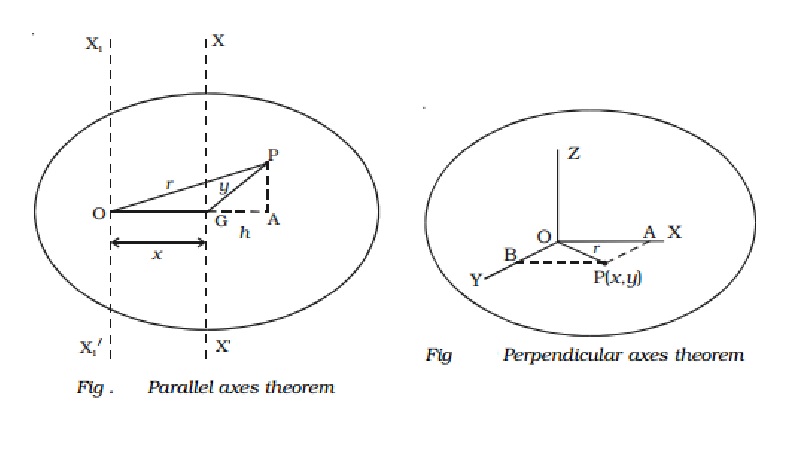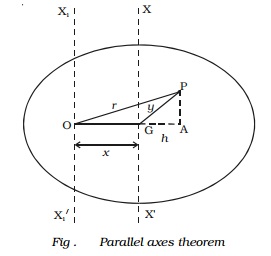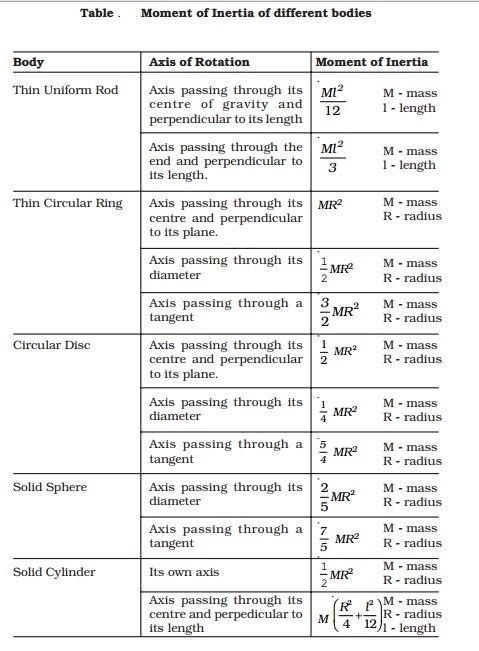Chapter: 11th 12th std standard Class Physics sciense Higher secondary school College Notes
Theorems of moment of inertia : Perpendicular and Parallel axes theorem

Theorems of moment of inertia
(i) Parallel axes theorem
Statement
The
moment of inertia of a body about any axis is equal to the sum of its moment of
inertia about a parallel axis through its centre of gravity and the product of
the mass of the body and the square of the distance between the two axes.
Proof
Let us consider a body having its centre of
gravity at G as shown in Fig.. The axis XX′ passes through the centre of gravity and is
perpendicular to the plane of the body. The axis X1X1′ passes through the point O
and is parallel to the axis XX′ . The distance between the two parallel axes
is x.

Let the body be divided into large number of
particles each of mass m . For a
particle P at a distance r from O, its moment of inertia about
the axis X1OX1′ is equal to m r 2.
The moment of inertia of the whole body about
the axis X1X1′ is given by,
I = Σ mr2 ???(1)
From the point P, drop a perpendicular PA to the
extended OG and join PG.
In the ∆OPA,
OP 2 = OA2 + AP 2
r2 = x2 + 2xh + h2
+ AP2 ???(2)
But from ∆ GPA,
GP 2 = GA2 +
AP 2
y 2 = h 2 + AP 2 ..(3)
Substituting equation (3) in
(2),
r 2 = x 2 + 2xh + y 2 ..(4)
Substituting equation (4) in (1),
I0
= Σ m (x2 + 2xh + y2)
= Σmx2 + Σ2mxh + Σmy2
= Mx2 + My2 + 2xΣmh
Here My2
= IG is the moment of
inertia of the body about the line passing through the centre of gravity. The
sum of the turning moments of all the particles about the centre of gravity is
zero, since the body is balanced about the centre of gravity G.
Σ (mg) (h) = 0 (or) Σ mh = 0 [since g is a constant]
equation (5) becomes, I0= Mx2 + IG
Thus the parallel axes theorem is proved.
(ii) Perpendicular axes theorem
Statement
The moment of inertia of a plane laminar body
about an axis perpendicular to the plane is equal to the sum of the moments of
inertia about two mutually perpendicular axes in the plane of the lamina such
that the three mutually perpendicular axes have a common point of intersection.
Proof
Consider a plane lamina
having the axes OX and OY in the plane of the lamina as shown
Fig. The axis OZ passes through O and is perpendicular to the plane of the lamina. Let the lamina be
divided into a large number of particles, each of mass m. A particle at P at a
distance r from O has coordinates (x,y).

∴r2 = x2+y2
The moment of inertia of the
particle P about the axis OZ = m
r2. The moment of inertia of the whole lamina about the axis OZ is
I Z= Σmr2
The moment
of inertia of the whole lamina about the axis OX is
Ix =Σ
my 2
Similarly,
I y= Σ mx 2
From eqn.
(2), I = Σ mr2 = Σ m(x2+y2)
I =
Σmx2+ Σ
my2 = Ix+ Iy
Iz
= Ix+ Iy
which proves the
perpendicular axes theorem.

List : Moment of Inertia of
different bodies
Body : Axis
of Rotation
Thin Uniform Rod
Axis passing through its
centre of
gravity and perpendicular to its length
Axis passing through the end
and perpendicular to its length.
Thin Circular Ring
Axis passing through its centre
and perpendicular to its plane.
Axis passing through its Diameter
Axis passing through a Tangent
Circular Disc
Axis passing through
its centre and perpendicular to its plane.
Axis passing through its diameter
Axis passing through a tangent
Solid Sphere
Axis passing through its diameter
Axis passing through a tangent
Solid Cylinder
Its own axis
Axis passing through its centre
and perpedicular to its length
Related Topics